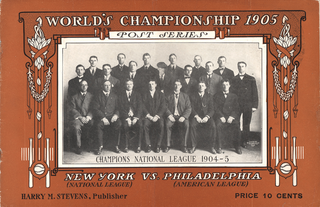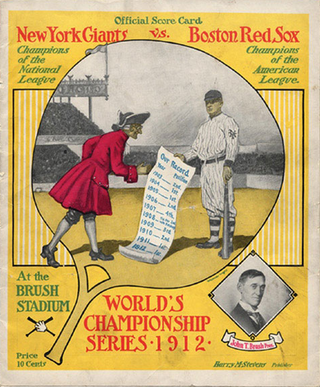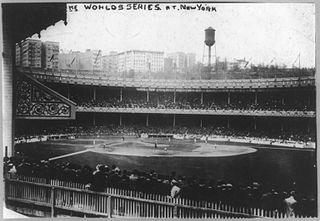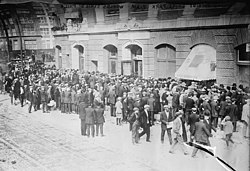
The 1905 World Series was the championship series in Major League Baseball for the 1905 season. The National League (NL) champion New York Giants defeated the American League (AL) champion Philadelphia Athletics, with the Giants winning 4 games to 1, now in a best-4-of-7 format. Four of the five games featured duels between future Hall of Fame pitchers. The games were the second edition of the World Series after the initial meeting in 1903, since the 1904 season ended with no Series held.

Christopher Mathewson, nicknamed "Big Six", "the Christian Gentleman", "Matty", and "the Gentleman's Hurler", was an American Major League Baseball right-handed pitcher, who played 17 seasons with the New York Giants. He stood 6 ft 1 in (1.85 m) tall and weighed 195 pounds (88 kg). He was among the most dominant pitchers in baseball history, and ranks in the all-time top 10 in several key pitching categories, including wins, shutouts, and earned run average. In 1936, Mathewson was elected into the Baseball Hall of Fame as one of its first five members.

The 2002 World Series was the championship series of Major League Baseball (MLB)'s 2002 season. The 98th edition of the World Series, it was a best-of-seven playoff between the American League (AL) champion Anaheim Angels and the National League (NL) champion San Francisco Giants; the Angels defeated the Giants, four games to three, to win their first, and, to date, only World Series championship. The series was played from October 19–27, 2002, at Pacific Bell Park in San Francisco and Edison International Field of Anaheim in Anaheim.

The 1910 World Series was the championship series in Major League Baseball for the 1910 season. The seventh edition of the World Series, it was a best-of-seven playoff between the American League (AL) champion Philadelphia Athletics against the National League (NL) champion Chicago Cubs. The series was played from October 17 to 23, with the Athletics winning the series 4 games to 1, clinching the team's first World Series.

The 1912 World Series was the championship series in Major League Baseball for the 1912 season. The ninth edition of the World Series, it matched the American League champion Boston Red Sox and the National League champion New York Giants. The Red Sox won the Series four games to three.

The 1913 World Series was the championship series in Major League Baseball for the 1913 season. The tenth edition of the World Series, it matched the American League (AL) champion Philadelphia Athletics against the National League (NL) New York Giants. The Athletics won the Series four games to one.

The 1924 World Series was the championship series of the 1924 Major League Baseball season. A best-of-seven playoff, the series was played between the American League (AL) pennant winner Washington Senators and the National League (NL) pennant winner New York Giants. The Senators defeated the Giants in seven games to win their first championship in club history. The Giants became the first team to play in four consecutive World Series, winning in 1921–1922 and losing in 1923–1924. Their long-time manager, John McGraw, made his ninth and final World Series appearance in 1924. The contest concluded with the second World Series-deciding game which ran to extra innings. In 1961, the Senators relocated to Minnesota and were rebranded as the Twins, subsequently winning the World Series in 1987 and in 1991.
The 1930 World Series featured the defending World Series champion Philadelphia Athletics against the National League (NL) champion St. Louis Cardinals. The Athletics defeated the Cardinals in six games, 4–2. Philadelphia's pitching ace Lefty Grove, and George Earnshaw, the No. 2 man in Mack's rotation, won two games apiece. Earnshaw also pitched seven scoreless innings as Game 5 starter, but ended up with a no-decision as Grove relieved him in the eighth and took the win on Jimmie Foxx's two-run homer in the top of the ninth for the game's only scoring.
The 1931 World Series featured the two-time defending champion Philadelphia Athletics and the St. Louis Cardinals. The Cardinals beat the Athletics in seven games, a rematch and reversal of fortunes of the previous World Series.
The 1933 World Series was the championship series of the 1933 Major League Baseball season. The 30th edition of the World Series, it matched the National League (NL) pennant winner New York Giants and the American League (AL) pennant winner Washington Senators. The Giants defeated the Senators in five games for their first championship since 1922 and their fourth overall. Key to the Giants' World Series triumph was the pitching of aces "King" Carl Hubbell and "Prince" Hal Schumacher.

The 1936 World Series was the championship series in Major League Baseball for the 1936 season. The 33rd edition of the World Series, it matched the New York Yankees against the New York Giants, with the Yankees winning in six games to earn their fifth championship.
The 1937 World Series featured the defending champion New York Yankees and the New York Giants in a rematch of the 1936 Series. The Yankees won in five games, for their second championship in a row and their sixth in 15 years.

The 1917 World Series was the championship series in Major League Baseball for the 1917 season. The 14th edition of the World Series, it matched the American League champion Chicago White Sox against the National League champion New York Giants. The White Sox won the Series four games to two. The Series was played against the backdrop of World War I, which dominated the American newspapers that year and next.

John Tortes "Chief" Meyers was a Major League Baseball catcher for the New York Giants, Boston Braves, and Brooklyn Robins from 1909 to 1917. He played on the early Giants teams under manager John McGraw and was the primary catcher for Hall of Famer Christy Mathewson. Meyers hit over .300 for three straight years as the Giants won three straight National League pennants from 1911 to 1913. Overall, he played in four World Series – the 1911, 1912, and 1913 Series with the Giants, as well as the 1916 Series with the Robins. Meyers was a Native American from the Cahuilla culture of California, and he was educated at Dartmouth College.
The following are the baseball events of the year 1911 throughout the world.

James Sanford Lavender was an American professional baseball player who played in Major League Baseball as a pitcher from 1912 to 1917. He played a total of five seasons with the Chicago Cubs of the National League from 1912 to 1916; after being traded to the Philadelphia Phillies, he played an additional season in 1917. During his playing days, his height was listed at 5 feet 11 inches (1.80 m), his weight as 165 pounds (75 kg), and he batted and threw right-handed. Born in Barnesville, Georgia, he began his professional baseball career in minor league baseball in 1906 at the age 22. He worked his way through the system over the next few seasons, culminating with a three-season stint with the Providence Grays of the Eastern League from 1909 to 1911.
The 1905 New York Giants season was the franchise's 23rd season, and the team won their second consecutive National League pennant. They beat the Philadelphia Athletics in the World Series.
The 1911 New York Giants season was the franchise's 29th season. The Giants won their first of three consecutive National League pennants. They were defeated by the Philadelphia Athletics in the World Series. The team set and still holds the Major League Baseball single-season record for stolen bases during the modern era, with 347.
The 1913 New York Giants season was the franchise's 31st season. It involved the Giants winning the National League pennant for the third consecutive year. Led by manager John McGraw, the Giants dominated the NL and finished 12½ games in front of the second place Philadelphia Phillies. They were beaten by the Philadelphia Athletics in the 1913 World Series.
The 2003 Major League Baseball postseason was the playoff tournament of Major League Baseball for the 2003 season. The winners of the League Division Series would move on to the League Championship Series to determine the pennant winners that face each other in the World Series. This was the first edition of the postseason where home-field advantage in the World Series was awarded to the league who won the MLB All-Star Game, a rule which lasted until 2016.

















